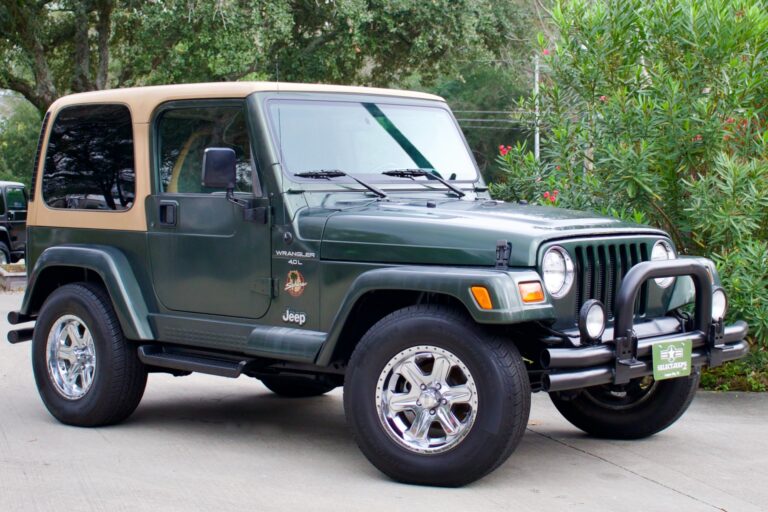Vintage Jeep For Sale: Your Comprehensive Guide to Finding, Buying, and Owning a Piece of Automotive History
Vintage Jeep For Sale: Your Comprehensive Guide to Finding, Buying, and Owning a Piece of Automotive History /jeeps.truckstrend.com
The rumble of a classic engine, the wind in your hair, and the unmistakable silhouette of a vehicle built for adventure – these are the hallmarks of a vintage Jeep. More than just a mode of transport, a vintage Jeep is a rolling testament to durability, simplicity, and an enduring spirit of exploration. From its humble beginnings as a military workhorse to its evolution into an icon of civilian freedom, the vintage Jeep holds a special place in the hearts of enthusiasts and collectors worldwide.
This comprehensive guide delves into the fascinating world of vintage Jeeps for sale, offering insights, practical advice, and essential information for anyone looking to embark on this unique automotive journey. Whether you’re a seasoned collector or a first-time buyer, understanding the nuances of these classic machines is key to a rewarding ownership experience. We’ll explore why these vehicles continue to captivate, what models to look for, how to navigate the buying process, and what it takes to own and maintain your very own piece of American history.
Vintage Jeep For Sale: Your Comprehensive Guide to Finding, Buying, and Owning a Piece of Automotive History
Why Buy a Vintage Jeep? The Enduring Appeal
The decision to purchase a vintage Jeep often stems from a blend of nostalgia, practicality, and an appreciation for mechanical artistry. Unlike modern vehicles laden with complex electronics, vintage Jeeps offer a raw, unfiltered driving experience that connects you directly to the road (or trail).
- Nostalgia and Heritage: Owning a vintage Jeep is like owning a piece of history. Models like the Willys MB evoke images of World War II heroism, while early CJs represent post-war resilience and the birth of recreational off-roading. This rich heritage provides a unique narrative that modern cars simply can’t replicate.
- Unique Driving Experience: Vintage Jeeps offer a driving experience unlike anything else. With manual transmissions, often no power steering or brakes, and an open-air design, they demand engagement from the driver. This simplicity fosters a deeper connection with the vehicle and the journey.
- Durability and Simplicity: These vehicles were built to be tough and easily repairable in the field. Their robust, mechanical nature means fewer complex systems to fail and often easier, more affordable repairs for the DIY enthusiast. Parts, especially for popular CJ models, are surprisingly abundant.
- Community and Lifestyle: Buying a vintage Jeep isn’t just about acquiring a vehicle; it’s about joining a vibrant global community. Owners share tips, participate in off-road events, attend classic car shows, and celebrate the unique culture surrounding these iconic machines.
- Investment Potential: While not all vintage Jeeps will skyrocket in value, well-maintained, original, or professionally restored examples of desirable models (e.g., early Willys, CJ-7 Scramblers) have shown consistent appreciation, making them a potentially sound investment alongside the enjoyment they provide.

Key Models and Eras: Understanding the Lineage
Defining "vintage" can be subjective, but generally, it refers to Jeeps produced before the modern Wrangler (YJ, TJ, JK, JL) era. This typically includes models from the early 1940s through the mid-1980s. Understanding the different models and their characteristics is crucial for identifying the right vintage Jeep for your needs.
- Willys MB / Ford GPW (1941-1945): The original "Jeep." Born from necessity during WWII, these military vehicles are the quintessential vintage Jeep. Known for their flat fenders, iconic grille, and utilitarian design, they are highly sought after by collectors for their historical significance.
- Willys CJ-2A / CJ-3A / CJ-3B (1945-1953): The first civilian Jeeps (CJ for "Civilian Jeep"). These models brought the ruggedness of the military Jeep to farms and recreational users. The CJ-2A introduced features like a tailgate and side-mounted spare tire, while the CJ-3B is recognizable by its taller hood (for the F-head engine).
- Willys / Kaiser CJ-5 (1955-1983): The longest-running CJ model, the CJ-5 evolved significantly over its nearly 30-year production run. Its compact size and classic round headlights are instantly recognizable. Variations include the "Tuxedo Park" luxury models and the more powerful "Renegade" packages.
- Willys / Kaiser CJ-6 (1955-1975): A long-wheelbase version of the CJ-5, offering more passenger and cargo room. Less common than the CJ-5, making them a bit rarer.
- AMC CJ-7 (1976-1986): The most popular civilian Jeep before the Wrangler. The CJ-7 offered a slightly wider track and longer wheelbase than the CJ-5, providing more stability and interior room. It also introduced options like automatic transmissions and full doors. Highly desirable for its balance of classic looks and improved driveability.
- AMC CJ-8 Scrambler (1981-1986): A pickup truck version of the CJ-7, featuring an extended wheelbase and a small bed. These are among the most collectible and valuable vintage Jeeps due to their relative rarity and unique utility.
- Jeep Wagoneer (SJ) / Cherokee (SJ) (1963-1991): While not traditional "Jeeps" in the open-top sense, the full-size Wagoneer and Cherokee models are increasingly sought after as vintage SUVs. Known for their luxurious interiors (especially later "Grand Wagoneer" models) and rugged capabilities, they represent a different facet of Jeep history.
- Jeep M-Series (Military): Other military variants like the M38 and M151 are also considered vintage but are often more specialized and harder to register for road use in some areas.


The Vintage Jeep Buying Guide: What to Look For
Purchasing a vintage Jeep requires careful consideration and a thorough inspection. Unlike buying a new car, you’re investing in a vehicle that has lived a life, and its condition will vary wildly.
1. Define Your Purpose and Budget
Before you start looking, decide what you want your vintage Jeep for.
- Daily Driver: Requires a more reliable, potentially resto-modded vehicle.
- Weekend Toy/Off-Roader: Might tolerate more quirks but needs solid mechanicals.
- Show Vehicle/Investment: Demands originality or a high-quality restoration.
- Restoration Project: Be prepared for significant time, money, and skill investment.
Your budget should account for the purchase price, potential immediate repairs, ongoing maintenance, insurance, and possibly restoration costs. A "cheap" vintage Jeep often becomes very expensive very quickly.
2. Condition Assessment: The Critical Inspection
This is the most vital step. If possible, bring a knowledgeable friend or, better yet, arrange a pre-purchase inspection (PPI) by a mechanic specializing in classic vehicles.
- Rust: The #1 Killer. Jeeps of this era are highly susceptible to rust.
- Frame: Inspect the frame rails thoroughly for rot, especially around spring hangers, body mounts, and crossmembers. This is paramount; a rusted frame can be a deal-breaker.
- Body: Check floorboards, rocker panels, fenders, cowl, and the rear tub area. Pay attention to areas where water collects.
- Underbody: Look at brake lines, fuel lines, exhaust system, and suspension components for excessive rust.
- Engine & Drivetrain:
- Engine: Look for oil leaks (minor seeps are common, but major leaks are a concern), smoke from the exhaust (blue for oil, white for coolant, black for fuel), and listen for knocks, ticks, or unusual noises. Check oil and coolant levels.
- Transmission: Test all gears, including reverse. Look for smooth shifting. For manuals, check clutch engagement.
- Transfer Case & Axles: Engage 4×4 (if possible) and listen for grinding or clunking. Check for fluid leaks from differential covers and axle seals.
- Electrical System: Vintage wiring can be brittle and prone to issues. Check all lights, gauges, wipers, heater, and horn. Look for frayed or aftermarket "spaghetti" wiring.
- Brakes & Steering:
- Brakes: Test pedal feel (should be firm), listen for squealing or grinding. Look for fluid leaks around wheels.
- Steering: Check for excessive play in the steering wheel. Look for worn steering box, tie rods, and drag link.
- Suspension: Inspect leaf springs for cracks or sag. Check shocks and bushings for wear.
- Tires & Wheels: Look for even tire wear, cracks, and overall condition. Check the spare.
- Interior: While often utilitarian, check seats, dash, gauges, and any aftermarket additions.
3. Documentation
A clear title is non-negotiable. Look for service records, previous restoration documentation, or any historical paperwork that adds to the vehicle’s provenance.
4. Where to Buy
- Online Marketplaces: Hemmings, Bring a Trailer (for higher-end examples), eBay Motors, ClassicCars.com, Facebook Marketplace.
- Specialty Dealers: Some dealers focus exclusively on vintage 4x4s. They often offer restored vehicles but at a premium.
- Auctions: Can be exciting but require quick decision-making and often don’t allow for thorough inspections.
- Private Sellers: Often found through online forums, local classifieds, or word-of-mouth. Can offer good deals but require more diligence.
- Forums and Clubs: Jeep-specific forums and clubs are excellent resources for finding vehicles and getting advice.
Restoration vs. Preservation vs. Resto-Mod
Once you own a vintage Jeep, or before you buy, consider its future path.
- Full Restoration: Aiming for factory-new condition, often exceeding original quality. This is a meticulous, expensive, and time-consuming process, typically reserved for rare or highly desirable models intended for show.
- Preservation: Maintaining the vehicle in its original, "as-is" condition, embracing its patina and history. Repairs are done sensitively to retain originality. Ideal for well-preserved, low-mileage examples.
- Resto-Mod: Combining classic aesthetics with modern performance and comfort. This often involves engine swaps, upgraded transmissions, power steering, disc brakes, and air conditioning. It makes vintage Jeeps more enjoyable and safer for regular driving but can significantly alter their originality.
- Partial Restoration / Driver Quality: Addressing critical mechanical issues, safety concerns, and major rust, while leaving some cosmetic imperfections. This is a common and practical approach for owners who want to enjoy their Jeep without breaking the bank.
Ownership & Maintenance Tips for Your Vintage Jeep
Owning a vintage Jeep is a rewarding experience, but it comes with responsibilities.
- Regular Maintenance is Key: Vintage vehicles thrive on consistent care. Adhere to oil changes, fluid checks (transmission, transfer case, differentials), greasing all zerks, and checking tire pressures.
- Rust Prevention: This cannot be overstressed. Keep your Jeep clean and dry. Consider applying rust inhibitors or undercoating, especially if you live in a humid or salted-road environment.
- Parts Availability: For most CJ models, parts are readily available from numerous aftermarket suppliers. Specialty parts for early Willys or rare trims might require more searching, often through dedicated forums or swap meets.
- Common Issues: Be aware of common vintage Jeep quirks: leaky seals, electrical gremlins (often due to old wiring), worn-out leaf springs causing sag, and steering slop. These are usually fixable with patience and the right resources.
- Community Resources: Join vintage Jeep clubs, online forums, and social media groups. These communities are invaluable for advice, troubleshooting, finding parts, and connecting with fellow enthusiasts.
- Insurance: Look into classic car insurance providers like Hagerty or Grundy. They often offer better rates and agreed-value policies that protect your investment more effectively than standard auto insurance.
Potential Challenges and Solutions
While rewarding, owning a vintage Jeep isn’t without its challenges.
- Rust: As mentioned, it’s a constant battle. Solution: Vigilant inspection, immediate repair of any spots, proper storage, and rust prevention treatments.
- Lack of Modern Comforts: No AC, power steering, power brakes, or sophisticated infotainment systems. Solution: Embrace the raw experience, or consider a "resto-mod" approach for modern creature comforts.
- Safety Features: Minimal compared to modern vehicles. Solution: Drive defensively, ensure all safety-related components (brakes, steering, tires, seatbelts) are in excellent condition.
- Finding Parts: While common parts are easy, specific or N.O.S. (New Old Stock) parts can be elusive. Solution: Network within the community, explore online specialty stores, and attend swap meets.
- Mechanic Expertise: Not all mechanics are comfortable working on older vehicles. Solution: Find a shop or individual with experience in vintage Jeeps or classic cars. Many owners learn to do their own maintenance and repairs.
- Value Fluctuation: The market for vintage vehicles can fluctuate. Solution: Buy for enjoyment first, and consider any appreciation a bonus. Focus on condition and originality if investment is a primary goal.
Vintage Jeep Estimated Price Guide
Please note: These prices are highly generalized and subject to significant variation based on specific model year, engine, transmission, options, geographic location, originality, and the seller’s motivation. This table provides a broad range for common models.
| Model | Representative Years | Condition: Project/Parts | Condition: Driver Quality | Condition: Restored/Excellent | Condition: Concours/Rare | Key Characteristics |
|---|---|---|---|---|---|---|
| Willys MB/GPW | 1941-1945 | $5,000 – $15,000 | $18,000 – $35,000 | $40,000 – $70,000+ | $75,000+ | Iconic WWII military vehicle, highly collectible. |
| Willys CJ-2A/3A | 1945-1953 | $3,000 – $8,000 | $10,000 – $20,000 | $25,000 – $45,000 | $50,000+ | Early civilian Jeeps, rugged and simple. |
| Willys/Kaiser CJ-5 | 1955-1983 | $2,000 – $7,000 | $8,000 – $18,000 | $20,000 – $35,000 | $40,000+ | Longest production run, classic compact design. |
| AMC CJ-7 | 1976-1986 | $3,000 – $10,000 | $12,000 – $25,000 | $30,000 – $55,000 | $60,000+ | More refined CJ, popular for daily driving/off-road. |
| AMC CJ-8 Scrambler | 1981-1986 | $5,000 – $15,000 | $18,000 – $35,000 | $40,000 – $75,000 | $80,000+ | Rare pickup variant, highly sought after. |
| Jeep Wagoneer (SJ) | 1963-1991 | $2,000 – $10,000 | $12,000 – $30,000 | $35,000 – $60,000 | $65,000+ | Early luxury SUV, especially "Grand Wagoneer" models. |
Note: "Project/Parts" indicates a vehicle requiring significant work or suitable only for parts. "Driver Quality" means runs and drives, but likely needs attention. "Restored/Excellent" implies a high-quality restoration or very well-maintained original. "Concours/Rare" refers to show-quality or exceptionally rare and original examples.
Frequently Asked Questions (FAQ)
Q1: What defines a "vintage" Jeep?
A: While there’s no single strict definition, "vintage Jeep" generally refers to models produced before the modern Wrangler era (pre-1987 YJ, TJ, JK, JL). This includes the Willys MB, CJ-2A/3A/3B, CJ-5, CJ-6, CJ-7, CJ-8 Scrambler, and full-size Wagoneers/Cherokees (SJ).
Q2: Are vintage Jeeps reliable for daily driving?
A: They can be, but it depends heavily on their condition and maintenance. A well-maintained or resto-modded vintage Jeep can be a reliable daily driver, but they lack modern safety features, comfort, and fuel efficiency. Expect a more raw and engaging driving experience, and be prepared for more frequent maintenance than a modern vehicle.
Q3: How much does it cost to restore a vintage Jeep?
A: Restoration costs vary wildly depending on the starting condition, the desired level of restoration (partial, full, concours), and whether you do the work yourself or hire professionals. A full, professional restoration can easily range from $25,000 to $75,000 or more, often exceeding the vehicle’s market value unless it’s a very rare or desirable model.
Q4: Where can I find parts for my vintage Jeep?
A: For popular models like the CJ-5 and CJ-7, parts are widely available from aftermarket suppliers like Quadratec, Omix-ADA, Morris 4×4 Center, and others. For older Willys models or specific components, you might need to search dedicated forums, swap meets, or specialized vintage parts dealers. The vintage Jeep community is also a great resource for finding elusive parts.
Q5: Is a vintage Jeep a good investment?
A: Many vintage Jeeps, especially well-preserved or properly restored examples of iconic models (Willys MB, CJ-8 Scrambler, certain CJ-7s, Grand Wagoneers), have shown consistent appreciation in value. However, it’s crucial to buy smart (good condition, desirable model) and maintain it meticulously. While they can be an investment, the primary motivation should be the joy of ownership.
Q6: What’s the best vintage Jeep for a beginner?
A: The AMC CJ-7 is often recommended for beginners. It offers a classic vintage look but with a slightly wider stance and more modern engine/transmission options than earlier CJs, making it a bit more comfortable and easier to drive. Parts availability is excellent, and there’s a huge support community.
Q7: Can I take a vintage Jeep off-roading?
A: Absolutely! Vintage Jeeps were built for off-road capability. However, be mindful of their age and condition. Ensure the frame is solid, suspension components are sound, and the drivetrain is in good working order. Many owners upgrade key components like brakes, steering, and suspension for safer and more capable off-roading. Always know your limits and the vehicle’s limits.
Conclusion
The journey of finding and owning a vintage Jeep is a unique adventure in itself. It’s a commitment to a piece of automotive history, a celebration of rugged simplicity, and an entry into a passionate community. From the historical significance of a Willys MB to the iconic lines of a CJ-7, each vintage Jeep tells a story and offers an unparalleled driving experience.
By conducting thorough research, performing diligent inspections, and understanding the realities of ownership, you can confidently navigate the world of vintage Jeeps for sale. Whether your aim is a pristine showpiece, a capable off-road companion, or a charming weekend cruiser, the right vintage Jeep is out there waiting for you. Embrace the quirks, enjoy the open-air freedom, and become part of the enduring legacy of the world’s most iconic 4×4. Happy hunting!





